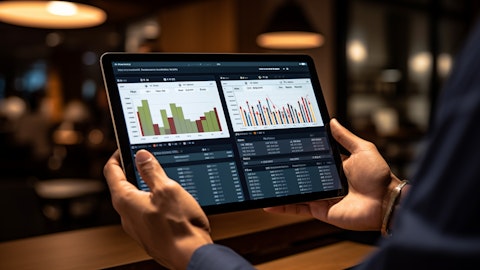Marc Casper: Yeah, Dan, thanks for the question on bioproduction. It’s definitely — to factor where it got in the queue of the questions, it says that the emphasis is reducing on that, so it’s becoming a little bit more predictable. Really, Q1 was in line with expectations. Organic growth did decline as we expected in the quarter due to the strong comparisons from a year ago. But when I look at orders, that’s now two quarters in a row with really good sequential bookings growth, nice improvement in book-to-bill, and when I look at the things that have been said externally about the quarter, I feel really good about our performance in terms of how we executed. So, working out in line with what we thought would happen. Thanks, Dan.
Operator: Thank you. The next question is from Matt Sykes with Goldman Sachs. Your line is open.
Matt Sykes: Hi, good morning. Thanks for taking my questions. Maybe just revisiting the AI segment and maybe just compare, contrast the end-markets and where you’re seeing some of the greatest strengths, it sounds like Industrial, Applied remained strong, but just would love to hear you kind of go through Biopharma, and Applied, Industrial, and Academic, Government and sort of the phasing of growth over the course of this year in those end-markets for AI? Thank you.
Marc Casper: Sure. So, when I think about the business, one of the things, Matt, is we really don’t manage it by end segment because effectively you produce a certain amount of products and then you ship them to specific customers. So you can have quarters where you ship more to an industrial customer, the exact same product as a biopharma customer, and therefore it kind of skews things. So, that’s my caveat around that. But when I look at the parts of the business, the Industrial and Applied, continues to have strong momentum in semiconductor, material science applications for electron microscopy was strong. So, in terms of how that played out, very difficult comparisons for all of the businesses based on the shipments a year ago, but that was strong. And then the other segments in terms of Academic and Government, Pharma and Biotech pretty much played out as we expected. So, nothing that really jumped out at me as being significant in terms of trends or patterns.
Matt Sykes: Got it. And then just for my follow-up, just on LPS and the margins. I know when you had acquired PPD, you talked about potential for long-term margin expansion in that business. Could you just maybe talk about some of the leverage you’ve got within LPS, understanding that revenue improvement would help a lot, but just any levers to get that margin within LPS to expand that over time?
Marc Casper: I’ll start, and then maybe Stephen will add a few additional thoughts. So, when I think about margins and obviously, you have different businesses there, the clinical research business, formerly PPD, incredibly strong operational execution, right? So, when you actually look at utilization rates, modification, all of the things that ultimately drive margins, they’re doing a great job and executing really well. We’re obviously benefiting from the synergies that we outlined, and we will have achieved all of our synergy targets on the cost side. So, that’s gone well. And so, they’re really doing a great job of just executing the trials really well and that bodes well for margin expansion along with volume. When I think about pharma services, they’re — the underlying is very strong, but we obviously have enough capacity coming online and also the runoff of the COVID revenues.
So, when you lose the volume, you see short-term pressure on margins. But if I say how is the team operating, actually the team is operating well. So, the margins there will expand as the year progresses and into the future as well. So, that will be my thoughts about margins. But I don’t know, Stephen, anything else?
Stephen Williamson: I think on the pharma services side, it’s the capacity coming online and switching over, there’s a cost to do that and as you’re ramping up the facility, bringing on the colleagues to be able to operate that facility, those are all facts that come into that. So, those are right drivers.
Marc Casper: Thanks, Matt.
Rafael Tejada: And operator, we have time for one more question.
Operator: Thank you. The last question we have time for today is from Luke Sergott with Barclays. Your line is open.
Luke Sergott: Great. Thanks for the question. So, I want to dig back in into the Biosecure Act and follow-up on what Rachel was asking about. But I wanted to know, Marc, what you guys are hearing from your customers and multinationals that operate over there? And what they’re saying to you regarding their assumptions on China retaliating and maybe excluding them from the region? I know, it seems pretty unlikely and it’s probably going to be limited, but is this something that is on their radar or some of those conversations that you’re having?
Marc Casper: Yeah. I can’t really speculate and be prudent on how — whether this thing will even come to pass and if it comes to pass, what is the response to it. Our job is to do a great job of supporting our customers globally to comply with the global regulations, both the actual regulations and the spirit of the regulations of the various countries and we’ll do a good job navigating it. So, that’s how I would think about it, Luke.





